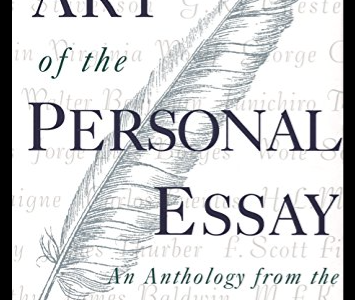JONATHAN LIM

Seneca the Younger and The Art of the Personal Essay, ed. Phillip Lopate
“On Noise” is an essay that reveals the musings of a man, known as a classic Stoicist, statesman, dramatist and satirist. Twelve of his essays survive, and in The Art of the Personal Essay editor, Phillip Lopate, four are collected. In this essay he tills the soil of his present circumstances, and turns over some delightful paradoxes.
Aside from his opening, where he lists the various and sundry noises assaulting him from his apartment in the middle of Rome, each paragraph in the essay turns over a subject carefully. From identifying two main sources of sound, first the general which is not distracting, and then the human voice, itself always arresting, he then goes into this verse: “The peaceful stillness of the night lulled the world to rest”.
Seneca argues that our reason for retirement is because our ambition has been piqued. This retirement is an unsuccessful one because ambition occasionally “rears its head again.” If we are to be truly retired, our thinking would be unbroken by the noise, and we would never face that type of distraction again.
We would assume after such a racket that this stillness would soothe. But what about the anxieties that surface in the night? Seneca argues that when the mind is most at rest, not only when lying down, but when it is hard at work and keeping idleness at bay, rest is achieved.
Seneca also states that being distracted or having an unstable temperament means that you have yet to attain a strong level of detachment. Without detachment, we are uneasy and become “prey to anxiety.” The example he gives us is an excerpt from the Aeneid in which the main character, Aeneas, who used to not fear anything, fears everything because of the burden he carries. This burden is his father and his son. Because of his attachment to keeping his load safe, every noise keeps him up and every breeze brings with it anxiety.
So, the day you are finally at rest is the day you have detached yourself and all the noises do not reach you. Seneca describes it as “a meaningless hubbub of empty sound”.
And then finally the ending plot twist. He’s outta here! Why should he have to endure the noise? What if Aeneas found a safe haven for his family and never had to deal with such fretful noises? Well sometimes, the answer is just to step away from the noise. Cause why suffer? Ulysses certainly didn’t.
Discuss Seneca’s “On Noise” with the “Expansions and Contractions of Self” from Lopate’s introduction.
When introducing a quote, usually the author would build off of it, as if the quote were a foundation for a house. However, Seneca does the opposite. After putting down a quote from the translations of Varro Atacinus, he immediately refutes it with the words, “This is incorrect.” In his introduction, Lopate says, “Personal essayists are adept at interrogating their ignorance.” If this was true, then why is it that Seneca’s “On Noise”, the first essay of the entire book, counters that? He gives out advice and shares his knowledge about noise, retirement, the strength of men, and detachment. However, in his salutation, he admits he’s had enough of the noise, a human reaction after all.
Seneca has achieved his goal: he is imperturbable, above the fray until the end, when he leaves. He states at the end of his essay that he was only subjecting himself to the maelstrom of noises in Rome “to give myself a test and some practice. Why should I need to suffer the torture…”? His character is set, built on rock solid Stoicism, and there seems to be nary a chink in the armor. However, his analysis can be too basic: “The temperament that starts at the sound of a voice or chance noises in general is an unstable one and one that has yet to attain inward detachment. It has an element of uneasiness in it…”.
“I cannot for the life of me see that quiet is as necessary to a person who has shut himself away to do some studying as it is usually thought to be,” and “But I swear that I no more notice all this roar of noise than I do the waves or the falling water…”.
To his credit, Lopate does attribute the exploration of the expansions and contractions of self to “personal essayists from Montaigne (1533–92) on”, and Seneca the Younger lived (c. 4 BC. to AD 65).
Lopate: “The personal essayist must above all be a reliable narrator; we must trust his or her core of sincerity. We must also feel secure that the essayist has done a fair amount of introspective homework already, is grounded in reality, and is trying to give us the maximum understanding and intelligence of which he or she is capable.”
Seneca’s confidence does not come off as arrogance, but rather, he has an educational tone. He is informing us of all he’s learned about the noise around us. We can see from his writings that he is sincere and reliable. Seneca’s goal is to give us the most knowledge possible of all that he has learned. We can trust that each word written by Seneca has a strong sense of confidence and wisdom behind it.
June Qin responds:
Lopate characterizes a personal essayist as “a Houdini who, having confessed his sins and peccadilloes and submitted voluntarily to the reader’s censuring handcuffs, suddenly slips them off with malicious ease.” Initially, Seneca seems to do exactly the opposite of what Lopate describes; he showcases his incredible ability to live above a public bathhouse that emits “a babel of noise” without going crazy. Yet, going back to the essay’s first sentence, he confesses that “I cannot for the life of me” understand why people need quiet to study; this inability later explained in the essay as he explains the paradox that peace isn’t attained through rest. Rather than continuing to expel his own limits, he uses the credible and stoic character that he built up in the beginning to explore humankind’s susceptibility to be “prey to anxiety.” I especially enjoyed Seneca’s example of a man urging everyone in his household to be quiet as he sleeps, but the noises he complains about, “he never heard them at all,” because they were imaginary which illustrates Seneca’s point of inner restlessness being more disruptive than external distractions. After this discussion, the ending in which he admits that he will move away from the public bathhouse, conceding that “it [is] a lot simpler just to keep away from the din,” seems unexpected, yet it is here where he echoes what Lopate implies: “I am more than the perpetrator of that shameful act; I am the knower and commentator as well.” His confession adds to his character’s complexity; he is more than just stoic.
Isaac weighs in:
When reading Seneca’s “On Noise” while also keeping in mind the make up of the personal essay, I find that Seneca’s essay slightly wanders off the well beaten path. His essay is less intimate than described. Though he does seem to speak directly to the reader, I didn’t find the companionship that Lopate mentioned. However, Seneca did follow the “Honesty, Confession, and Privacy” aspect of the essay. His writing is frank which also portrays him as a reliable author. After reading Jonathan’s response to the essay, I found his point on the tone to be interesting: “Seneca’s confidence does not come off as arrogance, but rather, he has an educational tone.” Seneca’s essay at times does seem too confident, but as Jonathan described, it is more educational which makes it a personal essay.








